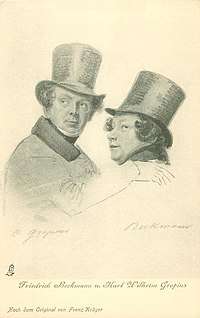Karl Wilhelm Gropius
Karl Wilhelm Gropius, also Carl Wilhelm Gropius (4 April 1793–20 February 1870), was a German set painter[1] and scenic artist, working in the theatres of Berlin.[2] He was also a printmaker and seller [3] and a prolific caricaturist.[4]


Life
Gropius was born in Braunschweig, the son of Wilhelm Ernst Gropius and his wife Lucie (née Graeffer). When he was still a child the family moved to Berlin where his father opened a mask factory and shop.[5] After training under his father in his teens he travelled in Europe to broaden his artistic education. In Paris he became familiar with the diorama theatre invented by Louis Daguerre and Charles Marie Bouton.[6] Returning to Berlin he trained under the artist and architect Karl Friedrich Schinkel as a landscape painter. From 1819 he worked as stage designer, artist and decorator for the Hoftheater (court theatre) and other Berlin theatres. In this capacity he designed inter alia the stage settings and backdrops for the premiere of Der Freischütz by Carl Maria von Weber which on 18 June 1821 opened the newly-rebuilt Schauspielhaus Berlin, designed by his teacher Schinkel.[7]
In Italy and Greece[8] he had assembled a large collection of views, which he put to use in the diorama theatre, based on Daguerre's, which he opened with his brothers in 1827 in the Georgenstraße, Berlin, which together with the Gropius's adjacent shop for art publications became a great success.[9]
He had many pupils, including Eduard Gaertner and Emil Roberg.
In 1822 Gropius was elected a member of the Prussian Academy of Arts.[6]
In 1836 he opened a factory producing Steinpappe ("stone paper"), which was basically papier maché strengthened with glue and precipitated calcium carbonate (or precipitate chalk; Schwämmkreide). This set to a stonelike consistency that took gilding well and was extremely easy to shape and cut, and was thus ideal for Gropius' stage settings and interior decorations.[10]
Gropius died in Berlin on 20 February 1870 and was buried in the Neue Dorotheenstädtische Friedhof.[10]
Family
In 1820 Gropius married Claudine Coste (1801–1827), with whom he had three children:[5] Paul, who was also an artist and took over his father's businesses and succeeded him as the decorator and scenic artist in the Hoftheater;[5] and two daughters, one of whom, Antonie, was the mother of the landscape artist Paul Flickel.[11] By his second wife, Jeanette Judée (1775–1855), he had no children.[5]
References
- Johannes Brahms (2001). Johannes Brahms: Life and Letters. Oxford University Press. p. 387. ISBN 978-0-19-924773-8.
- Benedict Taylor (5 July 2017). Mendelssohn. Taylor & Francis. p. 20. ISBN 978-1-351-55852-5. Retrieved 28 August 2018.
- British Museum
- Robert Dohme (1879), "Gropius, Carl", Allgemeine Deutsche Biographie (ADB) (in German), 9, Leipzig: Duncker & Humblot, p. 733
- Wirth, Irmgard. "Gropius, Carl". www.deutsche-biographie.de (in German). Deutsche Biographie. Retrieved 28 August 2018.
- Giacomo Meyerbeer (1999). The Diaries of Giacomo Meyerbeer: The years of celebrity, 1850-1856. Fairleigh Dickinson Univ Press. p. 125. ISBN 978-0-8386-3844-6. Retrieved 28 August 2018.
- Mark A Radice (ed.), 2003: Opera in Context: Essays on Historical Staging from the Late Renaissance to the Time of Puccini (online version)
- Lord Byron (1 March 2018). Byron's Complete Poetry. Seltzer Books. ISBN 978-1-4553-1826-1.
- Projects/Exeter.ac.uk: Bilder aus Berlin - Gutzkow: article with engraving of the Diorama
- Arnold Etzold and Wolfgang Türk, 2002: Der Dorotheenstädtische Friedhof. p.124. Ch Links Verlag ISBN 3861532611
- Ludwig Pietsch, "Waldlandschaft von Vilm" by Paul Flickel in Die deutsche Malerei der Gegenwart auf der Jubiläums-Ausstellung der Kgl. Akad. der Künste zu Berlin 1886, pp.93–94
Further reading
- Horst-Rüdiger Jarck, Günter Scheel (eds.): Braunschweigisches Biographisches Lexikon. 19. und 20. Jahrhundert, Hannover 1996, pp. 227f
- Erich Stenger, Daguerres Diorama in Berlin. Ein Beitrag zur Vorgeschichte der Photographie, Berlin 1925
- (in German) Karl Wilhelm Gropius. In: Ulrich Thieme, Felix Becker (editors): Allgemeines Lexikon der Bildenden Künstler von der Antike bis zur Gegenwart. Band XV, E. A. Seemann, Leipzig 1922, S. 87–88.
External links
| Wikimedia Commons has media related to Karl Wilhelm Gropius. |
- Artnet.de: Carl Wilhelm Gropius: Darstellung eines der sechs Bühnenbildentwürfe zu Schillers Wilhelm Tell (stage set designs for Schiller's Wilhelm Tell)